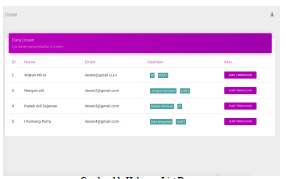Implementasi Metode Relational Unified Process Dalam Pembuatan Sistem Penjadwalan Bimbingan Tugas Akhir
Abstract
Abstract— Final project is one of the requirements that must be passed by students to complete their education. In the process of making the final project there is a guidance stage for the work of lecturers. The construction of the final assignment guidance scheduling system using the Relational Unfied Proccess (RUP) method aims to meet between lecturers and students, it is difficult to determine the schedule of meetings. In the RUP process there are 4 stages that must be passed in building a system. Inception at this stage the search for system requirements. Conducted by conducting interviews with students obtained a schedule for system development, 5 main functional needs of the system and 3 actors contained in the system. Elaboration is done by designing a system using the Unified Modeling Language. Beginning with the design with a use case diagram, proceed to the activity diagram and finally use the class diagram. The construction phase of the system is built based on the web using the programming languages ??PHP, HTML and CSS. Finally, in the transition phase the implementation at the construction stage will be tested using the blackbox method to test the functional system. In testing conducted on the login, submission of guidance, complaints and confirmation of submission obtained valid results for testing.
Downloads
References
[2] (2020) Institut Teknologi Sepuluh November. [online]. Available: https://www.its.ac.id/tki/wp-content/uploads/sites/53/2018/10/Pedoman TA-versi-ITS-2-converted.pdf.
[3] (2019) Brilio Net. [online]. Available: https://www.brilio.net/creator/bukan-malas-4-faktor-ini-bisa-jadi-penyebab-mahasiswa-telat-lulus-b574ab.html.
[4] Instruksi Presiden Republik Indonesia. 2003. Inpres Nomor 3 Tahun 2003 Tentang Kebijakan dan Strategi Nasional Pengembangan E- Government. Jakarta: Republik Indonesia.
[5] Yudhamanik Kusuma, Linawati, Made Sudarma, “Penentuan Pemanfaatan Aset Tanah Pemerintah Daerah dengan Sistem Informasi Geografis dan Metode Analitycal Hierarchy Process : Studi Kasus Pemprov Bali” Jurnal Teknologi Elektro. Vol. 16, No. 03. Sept - Des. 2017.
[6] Andhika Akbar Saputra, Yusi Tyroni Mursityo, Nanang Yudi Setiawan, “Pengembangan Sistem Informasi Reservasi Pada CV. Dwi Artha Indah Samarinda Menggunakan Metode Rational Unified Process” Jurnal Pengembangan Teknologi Informasi dan Ilmu Komputer. Vol. 16, Vol. 3, No. 3, hlm. 2379-2387, Maret 2019.
[7] Axel Reinno Fabiyanto, Yusi Tyroni Mursityo, Djoko Pramono, “Pengembangan Sistem Informasi Penilaian Kinerja Guru Menggunakan Metode Rational Unified Process (RUP) Berbasis Web (Studi Pada SD Negeri Prigen 1)” Jurnal Pengembangan Teknologi Informasi dan Ilmu Komputer. Vol. 3, No. 4, hlm. 3888-3895, April 2019.
[8] I M Sukarsa, K Yartono, “PENGEMBANGAN PLUGIN UNTUK RESERVASI HOTEL PADA MESIN CMS WORDPRESS”, Jurnal Teknologi Elektro. Vol. 9, No. 2. Pp. 221-230. Des. 2010.
[9] Shalahuddin M and A.S Rosa, Rekayasa Perangkat Lunak. Modula. Bandung, Informatika, 2011.
[10] Sekaran, Uma, “Research Methods For Business (Metode Penelitian Untuk Bisnis”, Jakarta : Salemba Empat.
[11] Keng Siau and Qing Cao, “Journal of Database Management”, ABI/INFORM Research. Pg. 26, 2001.
[12] B. B. Agarwad, C, “Software engineering and testing”, Jones and Bartlett Publishers, 2010.


This work is licensed under a Creative Commons Attribution-NonCommercial-NoDerivatives 4.0 International License.

This work is licensed under a Creative Commons Attribution 4.0 International License




